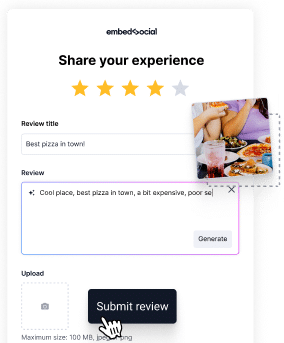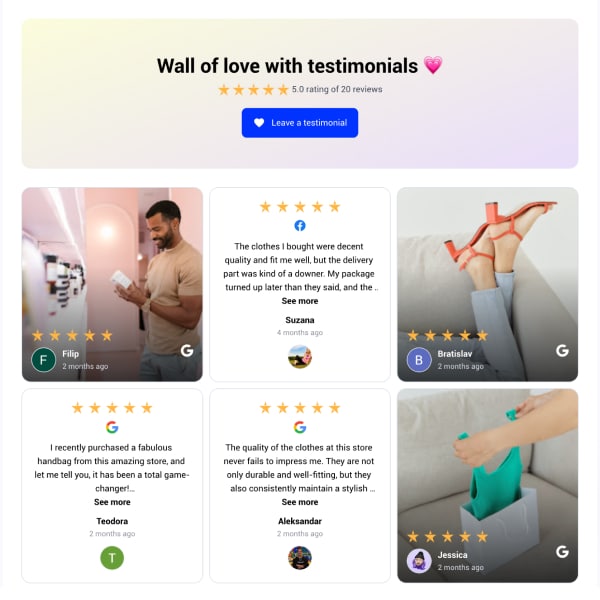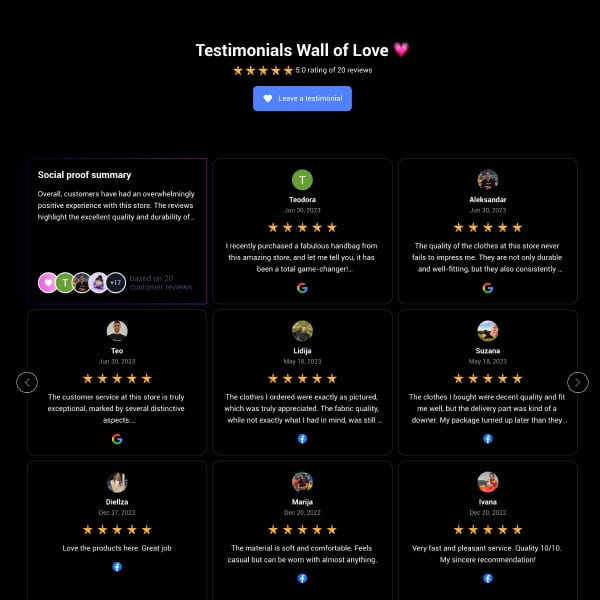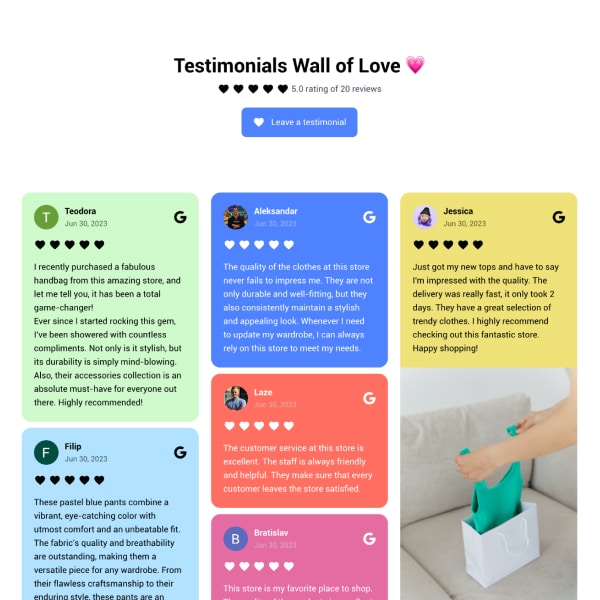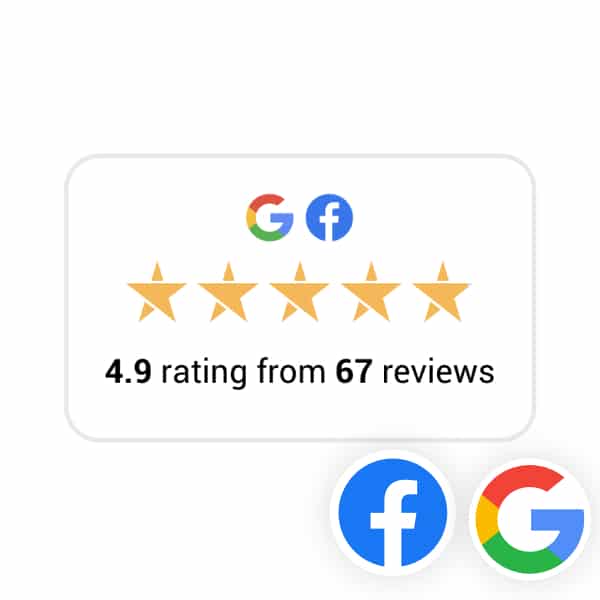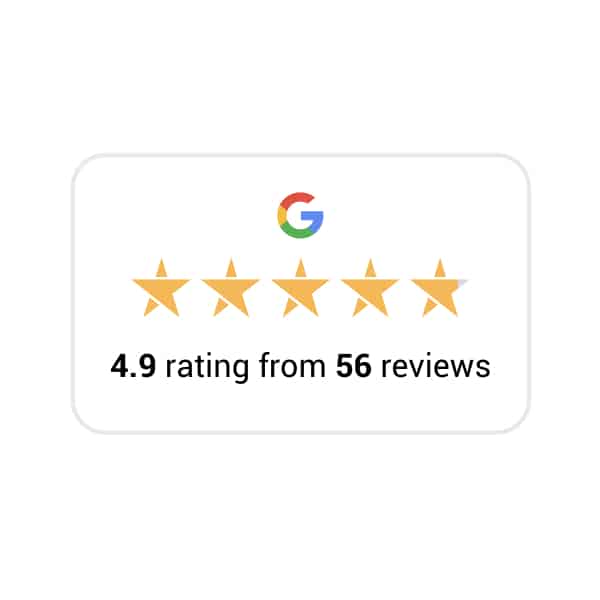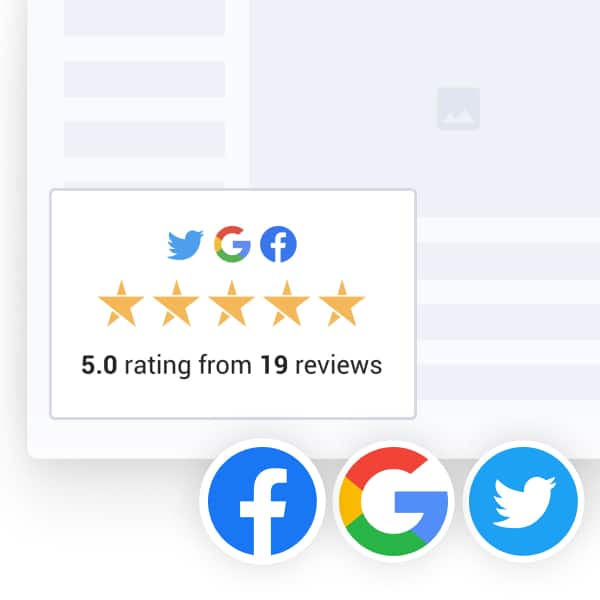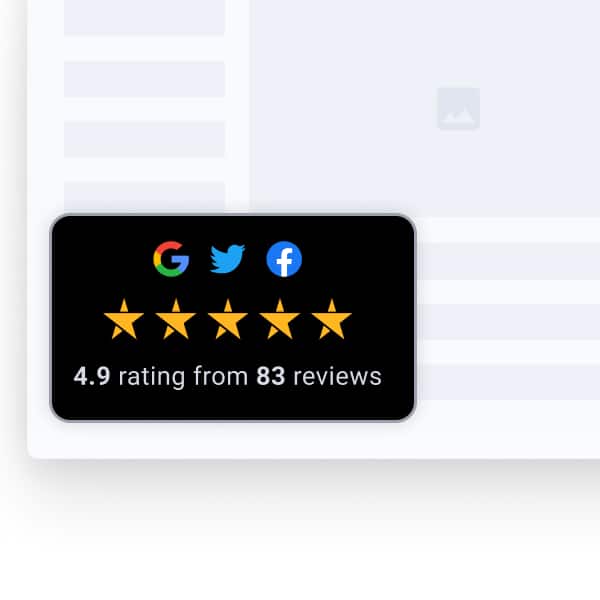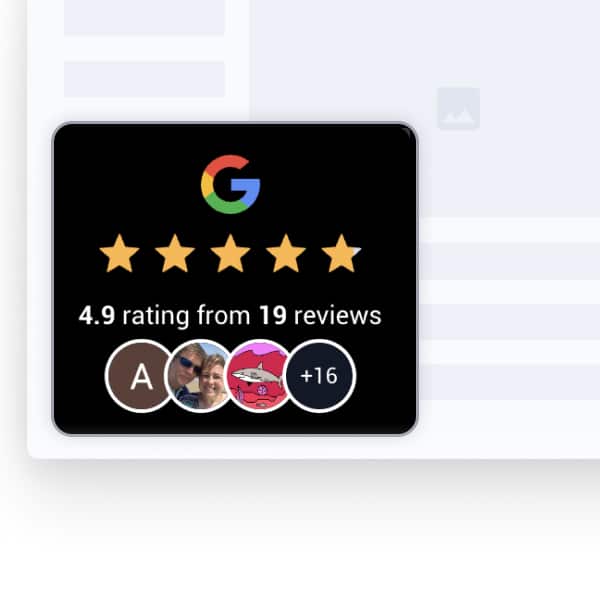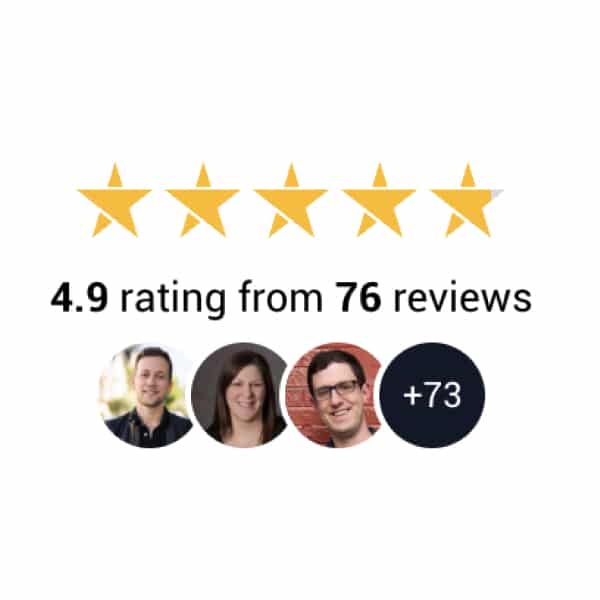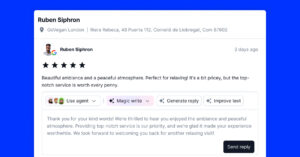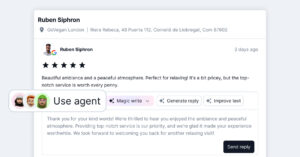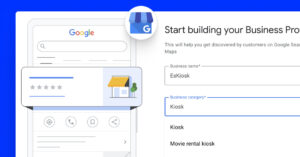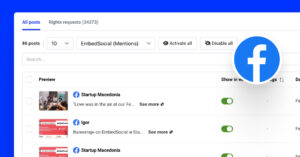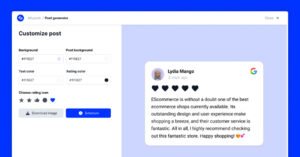We are a SaaS company, too, and we know that reviews and testimonials are pivotal to our success as a Software as a Service (SaaS) business.
But how do you effectively gather these testimonials, and more importantly, how can you utilize them to build trust and reputation to draw in more clients at the end of the day?
Below, we tell you all there is to know about testimonials for SaaS, including their benefits, how to collect them, and how to manage them. Plus, we list a few noteworthy examples.
Whether you’re a startup or an established brand, this guide will equip you with the tools needed to harness the power of testimonials in your marketing strategy right away!
What makes a good SaaS testimonial?
Good SaaS testimonials provide specific insights into how a SaaS solution has addressed a customer’s pain points and enhanced their operations, and they often include key elements such as:
- Clear problem–solution narrative: A strong SaaS testimonial clearly articulates the customer’s challenge or problem before using the SaaS solution, followed by a detailed account of how the software effectively addressed or resolved that issue;
- Measurable results and benefits: The best testimonials for a SaaS business include quantifiable results and benefits from using the product, which might encompass metrics like increased productivity, cost savings, and improved efficiency;
- Attribution and context: Providing the name, role, and industry of the endorsing individual or company adds a layer of authenticity. Additionally, offering context about the business’s size or specific use case can make the testimonial more relatable to customers;
- Permission and verification: Ensuring that the customer has given explicit permission to use their testimonial is crucial. Some businesses may also seek permission to allow potential customers to contact the endorsing party for verification;
- Multi-media elements: Including images, videos, or screen captures can enhance the testimonial’s impact, especially for SaaS solutions with a visual or user interface component. Partnering with a UI design agency is also a great way for small businesses to build trust and brand awareness in the market.
A well-crafted testimonial validates a SaaS product’s effectiveness and serves as a persuasive tool in the decision-making process for potential customers. After all, it provides real-world evidence of the solution’s value and establishes trust between the SaaS provider and their audience.
Why collect SaaS testimonials?
Collecting testimonials for your SaaS is a strategic investment that benefits your marketing efforts and contributes to long-term customer satisfaction and business growth.
Here’s how testimonials help your SaaS business prosper:
1. Differentiate your SaaS from competitors
Positive testimonials effectively set your SaaS product apart from competitors.
They highlight the distinctive features, strengths, and unique selling propositions that make your solution the preferred choice in a crowded market, giving you a competitive edge.
2. Encourage product improvement
Constructive customer feedback within testimonials can provide valuable insights.
Third-party opinions help you identify the failings of your products and how to improve them. This continuous refinement cycle demonstrates your commitment to customer satisfaction and ensures that your SaaS solution remains at the forefront of industry innovation.
3. Serve as a social proof
Your SaaS testimonials serve as an effective social proof.
After all, they demonstrate that real customers have found value in your SaaS solution—a collective endorsement that reinforces the credibility and reliability of your product.
4. Win more customers
Testimonials used in your marketing campaigns help you acquire new customers.
These authentic and positive customer experiences are compelling stories that clearly illustrate the most important benefits of choosing your SaaS product. They make a persuasive case for prospective clients to choose your software solution in different situations.
5. Build trust
Collecting SaaS testimonials is a fundamental strategy for building credibility and trust.
When potential users see positive feedback from satisfied users, they feel confident in your product’s ability to deliver on its promises, making them more likely to invest in you.
Types of SaaS testimonials
You can collect SaaS testimonials in various forms, all of which can exemplify the impact of your business’s software solutions, including all of the following:
- Text testimonials—written testimonials include concise and impactful statements about the customer’s positive experiences and the benefits they’ve gained from your SaaS;
- Video testimonials—the video testimonial format features customers sharing their firsthand experiences and feedback using your products and services; they offer a dynamic and personal touch since satisfied users are speaking directly to potential clients;
- SaaS case studies—some of the most impactful testimonials you can come across since they offer a detailed story (with background information) detailing the journey of specific customers who have successfully used your SaaS product to resolve a unique challenge;
- Social media mentions—customer mentions on social media platforms like Twitter, LinkedIn, Instagram, etc., can serve as powerful testimonials for SaaS companies; sharing screenshots or links to these mentions can add credibility to the company’s marketing efforts;
- UGC for SaaS products—UGC includes any content directly created by customers that showcases their experiences with a SaaS solution. This can encompass blog posts, screenshare videos, social media posts, or YouTube videos specifically related to the SaaS product or company.
- Online reviews and ratings—customer reviews on platforms like G2 Crowd, Capterra, or Trustpilot also serve as valuable testimonials for SaaS products; utilizing the positive ratings and excerpts found on these platforms can help you convert potential clients into paying customers;
- Email feedback—satisfied customers may also express their positive experiences with your SaaS product via email; with the customer’s permission, you can feature these messages in your marketing materials when promoting your brand and products.
Remember always to collect all the testimonials you could find, both positive and negative. While you can highlight the best ones, there’s much to learn from the “bad” ones.
How to collect testimonials for your SaaS?
Customer testimonials for software and SaaS companies can make or break their initial success. If you are running this type of company, consider the steps below on how to collect and embed testimonials on your website.
1. Build and embed a custom web form for testimonials
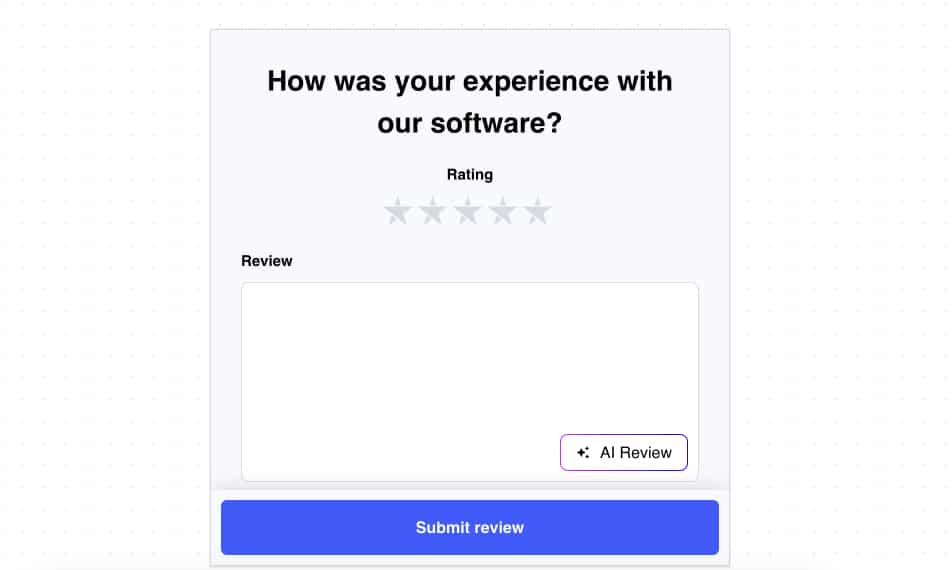
Building and embedding a web form on your website helps you gather specific and actionable testimonials from your customers quickly and reliably. Here’s a guide on how to do it:
- Choose a platform for your custom form: Use user-friendly form-building platforms like Google Forms, Typeform, Qualtrics, EmbedForms, etc. They offer customizable templates and straightforward interfaces for your testimonial forms;
- Craft clear and specific questions: Inside your chosen form platform, create targeted questions about customers’ experience with your SaaS, focusing on what features or aspects helped them resolve their issues and were most valuable to them;
- Add multiple-choice or dropdown options: Use multiple-choice or rating scale questions to gather structured feedback. Also, you can include a dropdown menu where the customers can choose which segment of your SaaS they want to rate;
- Add an open-ended testimonial section: Include a dedicated field in your form where customers can provide their experiences with your SaaS in their own words;
- Request permission for use: Add a checkbox or statement at the end of your custom form asking permission to use their testimonial in your marketing materials;
Embed the form on your website: Once you create the form, you can typically embed it on your website by copying a simple code into your web builder; remember to choose a prominent and visible section on the page so that users don’t miss it.
Testimonials for SaaS
To get a free testimonials form, signup for EmbedReviews and setup you own collect form with your own URL, that you can share via email, SMS, or create widget for your website. Additionaly, use reviewswidgets to display the testimonials on your website with a ‘Leave a review’ button included in the widget.
In case you need more custom forms with additional questions and types of fields, then EmbedForms will help you with more customization. It provides engaging web widgets that you can build from scratch without any prior coding knowledge or time investment.
2. Send a testimonial request email
Did you know that asking for testimonials via email is a very effective strategy?
It’s true! If you create compelling and personalized review request emails that acknowledge the user’s specific experiences with your SaaS brand and products and explain why you need their help, you’ll relate to them and increase your chances of getting a positive reply.
Here is an example:
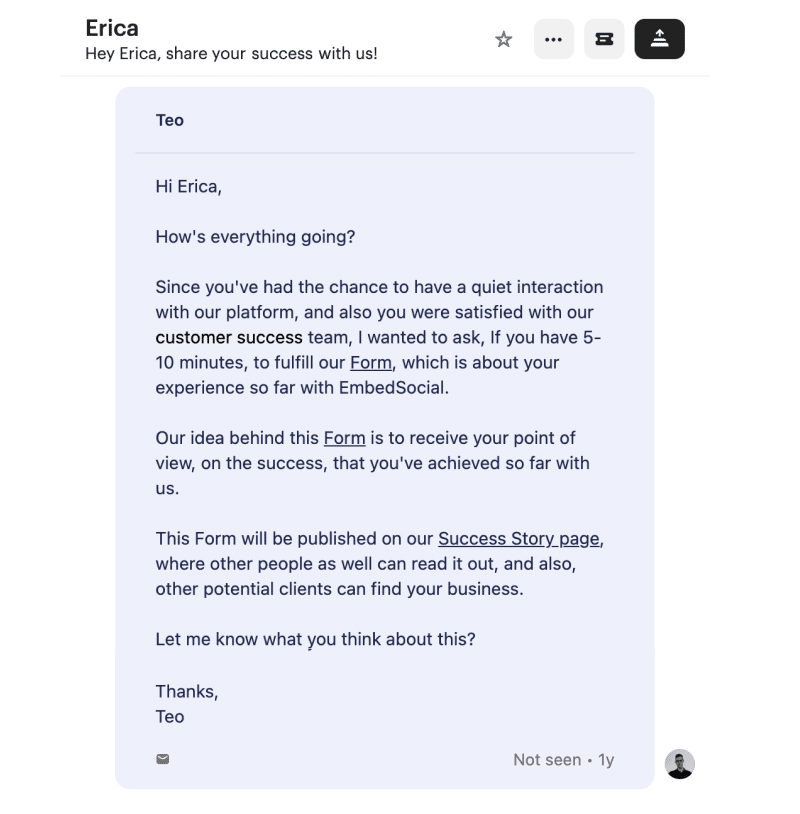
You must provide them with a simple testimonial collection form that won’t take too much of their time. You can tell them you’ll display their testimonials on your website to motivate them.
3. Send SMS to customers
Similar to emails, SMS messages are also an effective method to capture your audience’s attention and inspire them to send you quality feedback. However, keep in mind the following:
- Before sending SMS messages, ensure they match relevant data protection and privacy regulations, such as GDPR or CAN-SPAM;
- Create personalized SMS messages that address the customers by name and focus on their specific interactions with your SaaS products;
- Clearly explain why their feedback is important and how it can benefit both the user community and potential buyers evaluating your SaaS;
- Provide a link to a dedicated testimonial submission page where they can rate their experience with your SaaS solution and provide feedback.
Let’s look at how EmbedSocial composes its SMS requests for customer reviews:
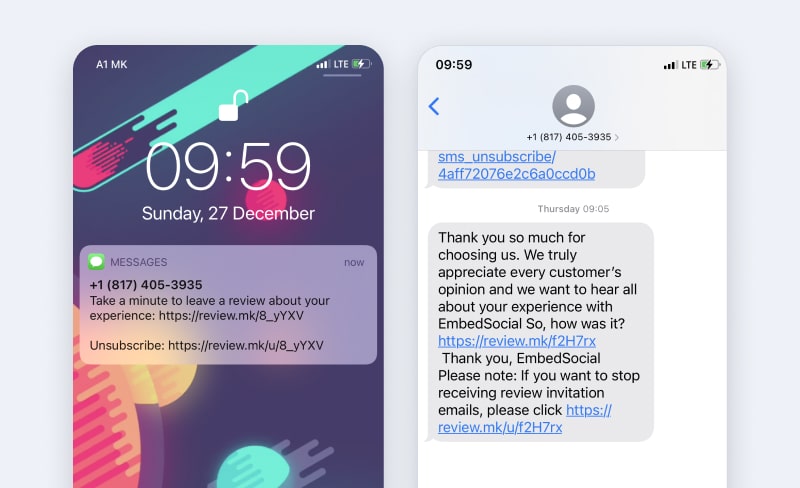
EmbedSocial’s message is courteous and appreciative and includes all the required links so users can quickly leave their feedback and stop receiving emails and SMS should they choose to.
4. Collect social media testimonials
Social media is often a treasure trove of customer feedback, and the only thing your marketing team needs to do is crawl through your profiles and relevant mentions to see what the public thinks of your brand and the quality of the products and services you offer.
On top of that, any feedback you come across on social media is extremely genuine, so once you find an especially laudatory testimonial, you should immediately contact the original author, asking for permission to use it in your marketing efforts!
Therefore, keep a close eye on platforms like Facebook, Twitter, Instagram, and LinkedIn, as they are the go-to online destinations for sharing feedback.
Note: You can encourage your users to share their experiences using a specific hashtag related to your SaaS products and services, which also makes review tracking easier. For example, Canva collects testimonials on a dedicated “Customer Stories” page and reshares them across multiple social media channels, too. Moreover, it encourages using hashtags like #MadeWithCanva, #CanvaCommunityAwards, etc.
5. Call your customers or ask to provide testimonials on a zoom call
For SaaS companies that are already leveraging Zoom for demos and presentations, collecting testimonials during these calls is a game-changer.
At EmbedSocial, we view each Zoom call as more than just a meeting; it’s a golden opportunity to deepen customer relationships and gather authentic testimonials. The key is to make this part of your customer’s journey, turning a regular demo or presentation into a valuable touchpoint for feedback.
Bratislav Petrovski, Account manager at EmbedSocial
With your customer’s permission, record the Zoom call. The beauty of recording is that it captures those genuine, unscripted moments that written testimonials often miss.
By integrating this simple yet effective strategy into your Zoom interactions, you collect powerful testimonials and reinforce customer trust and loyalty.
10 examples of leveraging SaaS testimonials
Effectively managing your SaaS testimonials is an important aspect of leveraging social proof to its fullest potential. Let’s see the best practices that ensure your testimonials shine a positive light on your SaaS solution and resonate strongly with potential clients.
We also included examples of how real SaaS companies use their testimonials to engage and get more customers.
1. Create a ‘Wall of Love’ page on your website
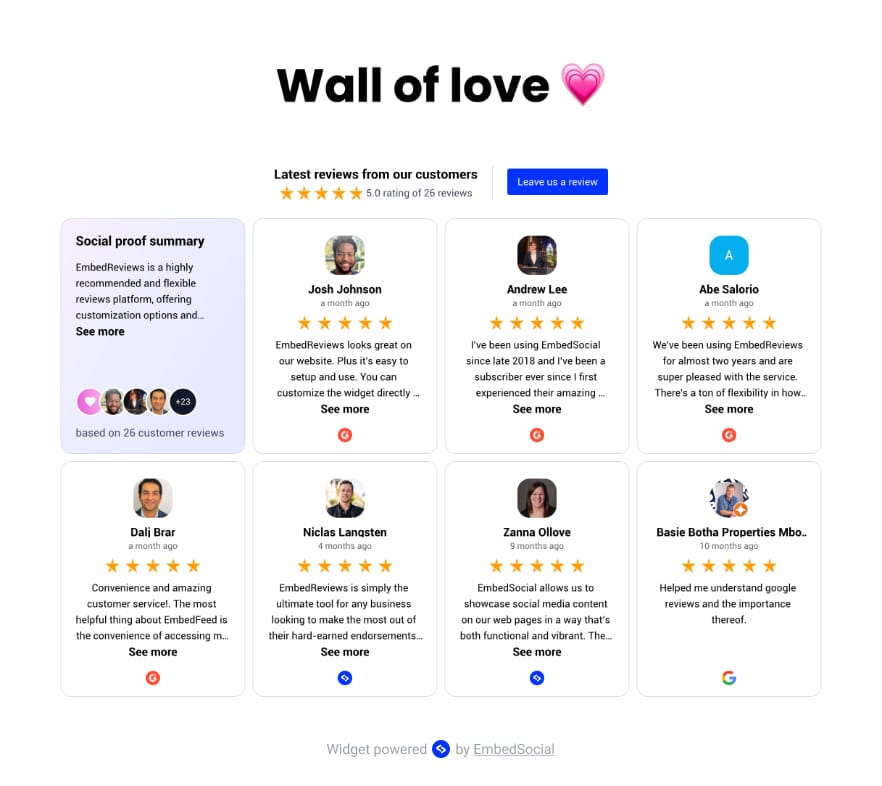
Maintaining a centralized repository for your SaaS testimonials is a must-have asset in testimonial management since it ensures all feedback is systematically organized and accessible.
That’s why SaaS businesses create a hub of customer validation, which is a ‘Wall of Love’ on their website—a page that collates all testimonials in one place.
After all, you can source your reviews and testimonials from various platforms, including G2, Trustpilot, Google, Facebook, LinkedIn, email, or even in person.
This systematic approach helps you streamline the process of uncovering all your testimonials and maintaining an up-to-date record you can access at any time.
To get started and embed your Wall of Love now, choose one of our pre-defined templates:
2. Add testimonials sliders on your landing pages
Displaying testimonials slider front and center on your website provides impactful social proof to your visitors, thus making them eager to trust your brand.
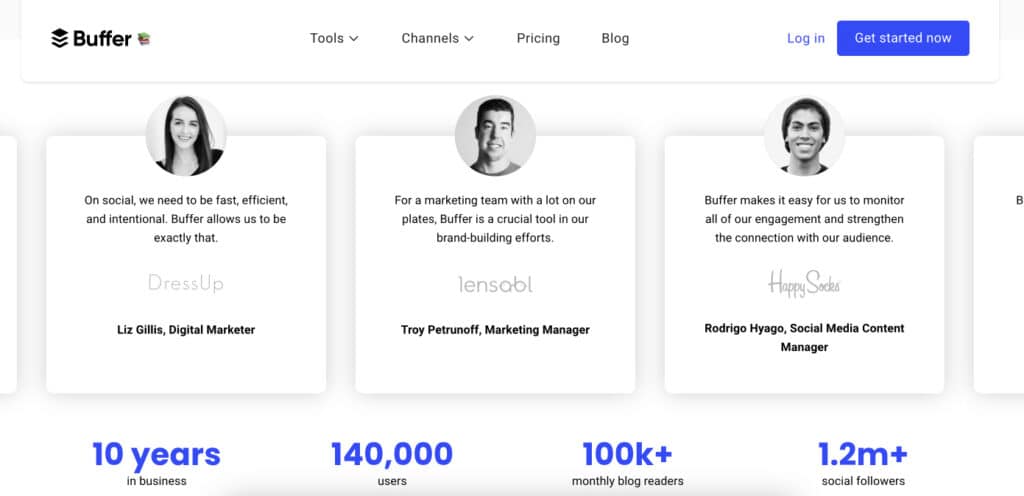
Getting started
To embed your own reviews and testimonials slider, check the our pre-built widgets library:
3. Use testimonials in your SaaS marketing materials
In addition to displaying them on your website, you can also repurpose all the positive reviews and testimonials you obtain in your marketing efforts, including blog posts, landing pages, eBooks, case studies, webinars, social media posts, traditional ads, etc.
Doing so reinforces your messaging with real-life success stories, which offer a value proposition that persuades potential customers to try out your SaaS services.
Just look at how HubSpot utilizes the feedback obtained from their customers to create detailed case studies displayed prominently on their website:
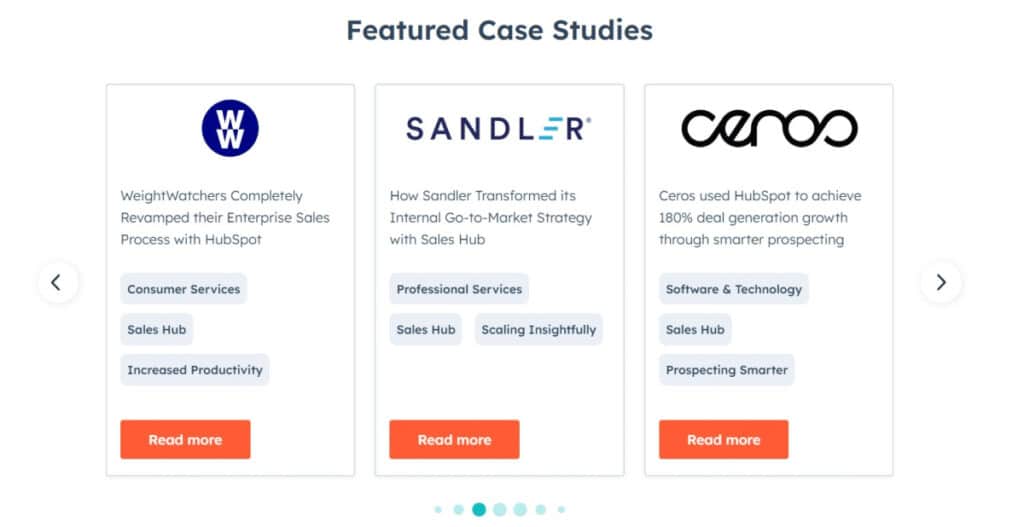
4. Implement testimonials in your email campaigns
User testimonials can be a powerful weapon in your email campaigns, too, as they can be used in all kinds of emails, from newsletters to sales pitches. Ultimately, testimonials provide irrefutable social proof that always increases your brand’s engagement rates.
Take Section as an example: an online courses platform that chose the email format to highlight a specific feature of theirs through a testimonial posted by their users:
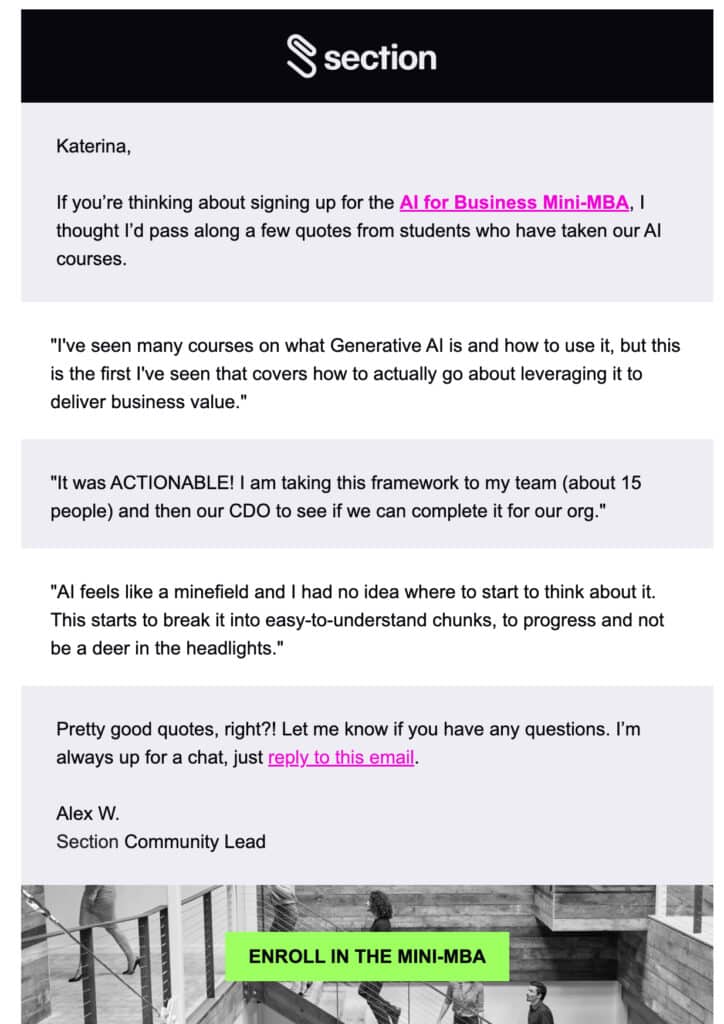
5. Create promotional video testimonials
Video testimonials offer a dynamic and engaging way to showcase customer satisfaction. At the end of the day, they provide a human touch, allowing potential customers to connect emotionally with the brand thanks to the positive experiences shared by others.
Creating short video clips featuring customers discussing how your SaaS solution has streamlined their processes or solved their pain points is a compelling addition to any marketing strategy. Once you have them, you can exhibit them across all your online channels.
For example, check out Figma’s video testimonials for its design product:

6. Embed interactive badges for reviews collected from Capterra, G2, and more
You can also directly pull and embed your testimonials as found on other review sites.
Platforms such as Capterra, G2, and Trustpilot regularly collate reviews and testimonials for all kinds of products, and since they do not prompt users for them, you can find some of the most honest and valuable feedback on the internet on these sites.
Here are examples of rating badges you can start using right now:
7. Add customer testimonials on signup start trial pages
This is one of the most important pages for any SaaS business, and having previous customer testimonials can drastically improve the conversion rate.
Here is an example of how we use our reviews widget to display our latest customer reviews:
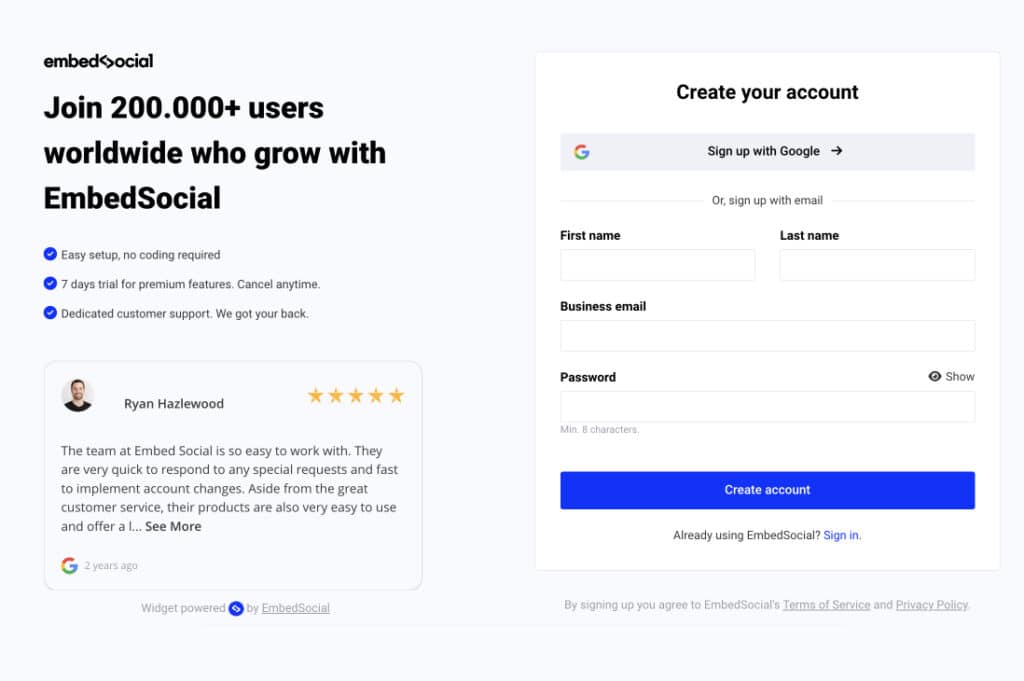
8. Post testimonials on social media
Social media is a powerful way to share your SaaS testimonials and build community around your tool.
For example, we at EmbedSocial regularly post screenshots of our customers’ testimonials and share them on social media, such as our LinkedIn page or Instagram profile:
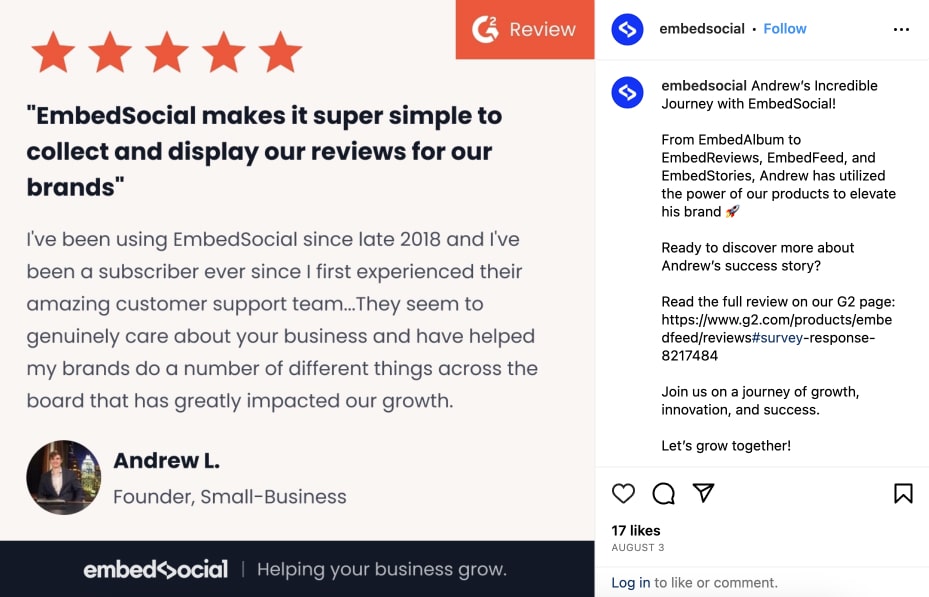
With this approach, we try to demonstrate our UGC platform’s benefits and positive impact, fostering trust and showing our customers’ experiences.
9. Use SaaS testimonials in paid ads
Using SaaS testimonials in paid ads involves incorporating customer feedback or success stories into your advertising campaigns on various platforms like Google Ads, social media, or other digital advertising channels. A good example of this approach is AppSumo.
AppSumo serves as a SaaS platform tailored for entrepreneurs to both purchase and sell digital products. They actively use paid campaigns to show successful customer stories, promote webinars, etc. Here is an example:
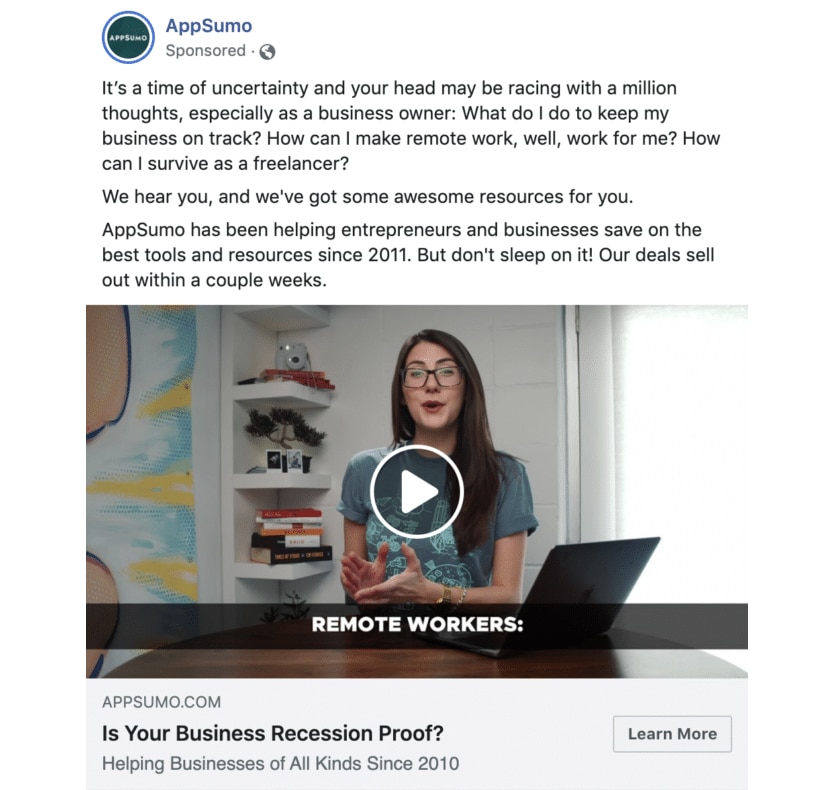
10. Add SaaS testimonials near the pricing plans
Add testimonials near your SaaS pricing plans to reassure potential customers of the value they’ll receive. They will have a chance to read what other people said about your SaaS solution and directly choose a plan for their needs.
We have a great example – EmbedSocial 🙂 It is a widely used UGC platform that allows users to collect and embed user-generated content.
We constantly update the received testimonials in a reviews slider below the pricing plans so that potential users can read about our current users’ positive experience:
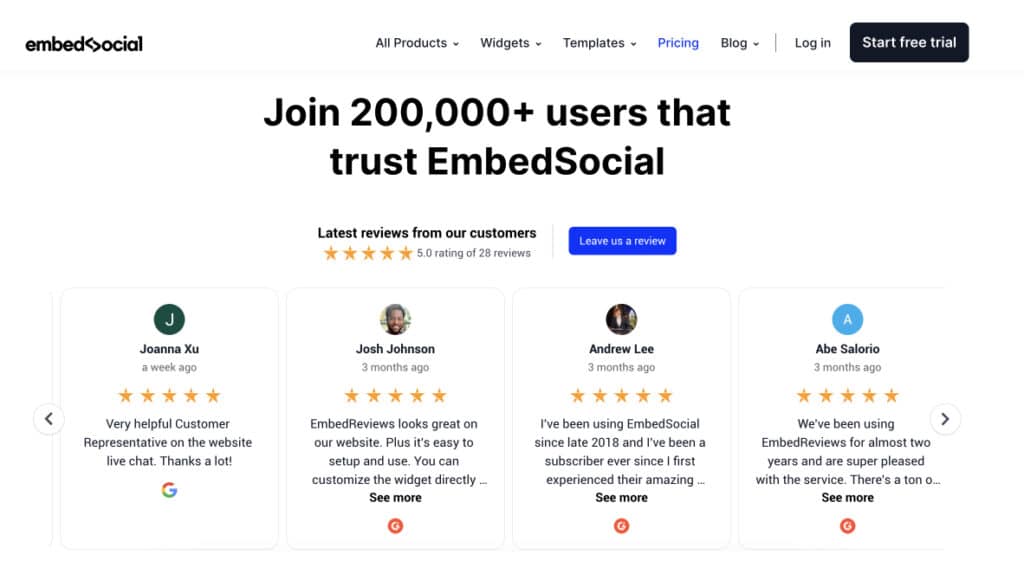
SaaS testimonial questions: what should I ask
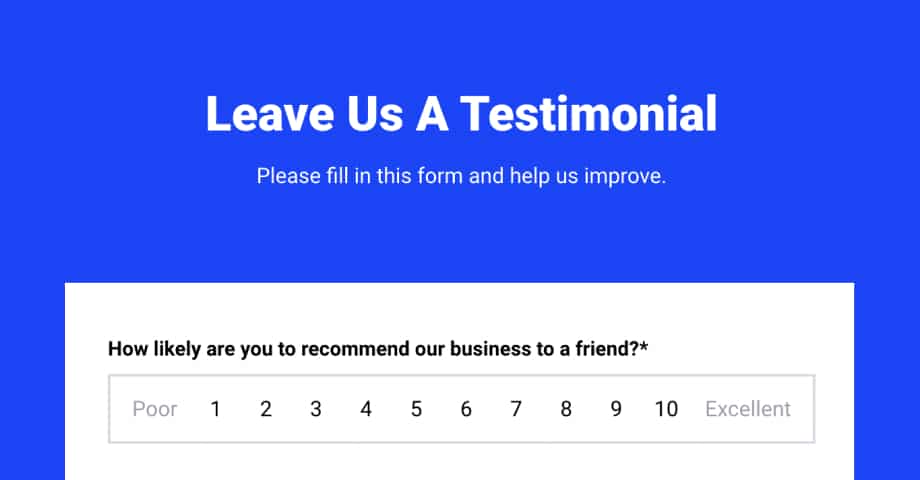
The quality of your testimonials is directly proportional to the questions you ask to elicit them. So, what should you be asking? Here are some suggestions:
- What specific challenges were you facing before using our SaaS solution?
- How did our SaaS solution make a difference in achieving your business goals?
- What features of our SaaS solution are most helpful for your day-to-day tasks?
- How has our SaaS product improved your workflow or business processes?
- What makes our SaaS solution stand out from other software you’ve used in the past?
- Would you recommend our SaaS solution to others in your industry? Why?
- Can you share any notable achievements accomplished with our SaaS product?
- How would you rate the customer support and service you’ve received from us?
- Have you noticed any time savings or productivity improvements since using our solution?
Is there anything else you’d like to share about your experience with our SaaS product?
Read more:
Managing SaaS Testimonials
Once you collect your testimonials is very important to monitor, analyze, and respond to your users’ feedback.
The options listed below are part of the EmbedRevies reviews management software:
1. Monitor reviews
EmbedReviews provides a few options to manage your testimonials in one place better.
The reviews page offers features like tagging, search, and options to quickly reply to a review on Google.
Implementing a robust tagging function with various filtering options, such as product features, industries, or customer demographics, is also necessary, as you need to quickly locate specific and relevant testimonials for improving your offerings and finding praiseful feedback.
2. Generate reports
Generating customizable reports with pre-applied filters can be a very beneficial feature for marketing professionals looking to boost their brand’s image or marketing efforts.
By using the time period filters, you will be able to analyze the number of reviews you received and also see if there is a change in the users’ sentiment that you can quickly act upon.
3. Export and integrate with the CRM system
Using the EmbedReviews platform, you can export and import the generated testimonials into your CRM.
This gives your sales teams valuable insights and references to leverage in their interactions, thus building stronger customer relationships while empowering their sales numbers.
Start collecting testimonials today
Implementing certain strategies for collecting and managing SaaS testimonials is key to the SaaS success recipe. SaaS businesses should collect and leverage testimonials to attract and convert more clients, ultimately driving business growth and success.
Here are 6 key takeaways you should focus on:
- Testimonials build trust: Trustworthy testimonials play a vital role in establishing trust with potential clients.
- Use incentives: To encourage active participation in the testimonial-collecting process, consider implementing incentives or rewards for customers who share their experiences.
- Leverage video testimonials: Video testimonials offer a dynamic and engaging medium for customers to share their experiences.
- Strategic placement Matters: The strategic placement of testimonials across various touchpoints is crucial for maximum impact.
- Use Testimonials in paid advertising: Integrating testimonials into your paid advertising campaigns elevates the credibility of your messaging.
- Tailor Testimonials for different audiences: Recognize the diverse needs and interests of your target demographics and industries.
